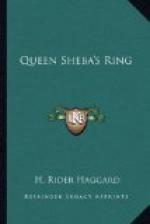We started forward again along various passages, the last of which suddenly widened into a broad and steep incline of rock, which we followed for quite fifty paces till it ended in what seemed to be a blank wall. Here Maqueda bade her ladies and attendants halt, which indeed they seemed very anxious to do, though at the moment we did not know why. Then she went to one end of the wall where it joined that of the passage, and, showing us some loose stones, asked me to pull them out, which I did, not without difficulty. When an aperture had been made large enough for a man to creep through, she turned to her people and said:
“You, I know, believe this place to be haunted, nor would the bravest of you enter it save by express command. But I and these strangers have no such fears. Therefore give us a gourd of oil and some torches and bide where you are till we return, setting a lamp in the hole in the wall to guide us in case our own should become extinguished. No, do not reason but obey. There is no danger, for though hot, the air within is pure, as I know who have breathed it more than once.”
Then she gave her hand to Oliver, and with his assistance crept through the hole. We followed, to find ourselves in another cavern, where, as she had said, the temperature was much hotter than that without.
“What is this place?” asked Orme in a low voice, for its aspect seemed to awe him.
“The tomb of the old kings of Mur,” she replied. “Presently you shall see,” and once more she took his hand, for the slope was sharp and slippery.
On we went, always descending, for perhaps four hundred yards, our footfalls echoing loudly in the intense silence, and our lamps, round which the bats circled in hundreds, making four stars of light in the utter blackness, till at length the passage widened out into what appeared to be a vast circular arena, with a lofty dome-like roof of rock. Maqueda turned to the right, and, halting before some objects that glimmered whitely, held up her light, saying, “Look!”
This was what we saw: A great stone chair and, piled upon its seat and upon its base, human bones. Amongst these was a skull, and on it, grotesquely tilted, a crown of gold, while other ornaments—sceptres, rings, necklaces, weapons and armour—were mingled with the bones. Nor was this all, for in a wide circle round the chair were other skeletons, fifty or more of them, and amongst them the ornaments that their owners had worn.
Also, in front of each stood a tray of some metal, which we afterwards discovered to be silver or copper, and heaped upon it every kind of valuable, such as golden cups and vases, toilet utensils, necklaces, pectorals, bracelets, leglets, earrings and beads that seemed to be cut from precious stones, piles of ring money, and a hundred other things such as have been prized by mankind since the beginning of civilization.




